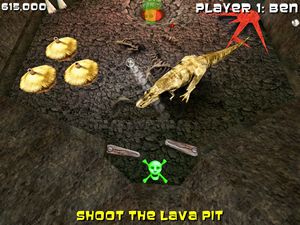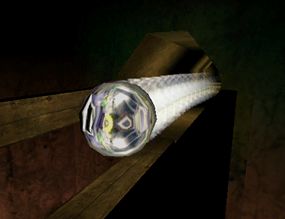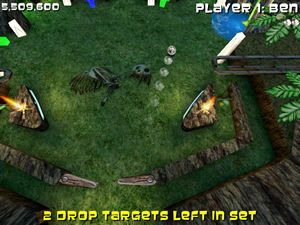The game that time forgot.
Most paleontologists believe in the Alvarez Asteroid Impact Theory, which claims
that a giant runaway rock caused the extinction of the dinosaurs. Others point
to the Volcano/Greenhouse Gas Theory, which suggests that a large volcanic eruption
had eroded the ozone layer, leading to a devastating greenhouse effect. A select
few even subscribe to the Arctic Ocean Spillover Theory, which involves some ribald
bathtub analogies.
Now I may not have a Phd in Paleo-dinoconomics, but I think I can safely say
that each of the above theories, while certainly compelling, is totally wrong.
After much study and a few bottles of Merlot, I have discovered the real reason
dinosaurs went extinct.
Giant, metal balls, folks. Giant, metal balls.
Indeed, these mysterious iron spheres cut a swathe through the giant lizards
like a knife through butter. Where did the balls come from? Why were they there?
I don’t know. I told you I didn’t have a Phd. Stop asking me tough questions.
But I swear this is how it happened, and I submit Adventure Pinball: Forgotten
Island as proof. Sadly, this new one from EA offers an answer to the age-old
debate, but it doesn’t offer much more.
Oddly, this isn’t the first arcade-pinball game set in prehistoric locations.
Sierra’s 3D Ultra Pinball: Lost Continent already marked
that territory. Apparently, they didn’t mark it well enough, since the folks
at EA decided that the arcade pinball genre was fertile ground.
Pinball games inevitably fall into one of two types: hardcore simulation and
arcade hi-jinks. Adventure Pinball is certainly the latter, opting for
big, wacky tables and relatively forgiving physics. In fact, it forgoes some
of the things that makes pinball, well, pinball, in favor of…well, nothing.
Confused? Allow me to explain.
There’s actually some retarded story here, something to do with a caveman named Ooga. Whatever. The bottom line is that you use flippers to smash a ball around prehistoric-themed tables.
There are 9 total levels (tables) to enjoy, though you have to ‘pass’ one
before you can play the next. Each table has a goal, usually requiring you to
nail a few ramps or drop targets and shoot the ball through a big hole. Then
it’s on to the next table.
Each table features different tiers. You’ll hit the ball up a ramp, which
takes it to another part of the table, complete with new flippers and whatnot.
If you lose the ball here, it simply goes back to the last tier. This makes
it easy to keep one ball alive for a long time, since you can only lose the
ball on the first screen.
Adventure Pinball uses the Unreal
engine, which leads to some really pretty moments. The particle effects are
fantastic and the action is pretty smooth. Lots of cute little dinosaur animations
pepper each level, and occasional cut-scene quality sequences of the ball rolling
down a ramp to open up a new area help bring the environments to life.
 Too
Too
bad it doesn’t sound as good as it looks. There’s actually an announcer, who
repeatedly spouts such riveting lines as “Here We Go!” and “Great Shot!” (even
when you hit a distinctly un-great shot). On the flipside, the ‘ooga’ sound
during the menu screens is a gas.
Adventure Pinball makes a tragic mistake by only allowing you one camera
option. The camera is fixed on the ball, which does make it more cinematic.
Yet it also makes it hard to judge where you’re aiming. When the ball gets moving
quickly, things get a bit nauseating, and you can’t pull out to a wider zoom
and see the whole table. This gets really frustrating.
To make matters worse, the fixed camera means there is never a multi-ball…which
is sort of a big reward in standard pinball. It’s just you and one ball, eternally
bouncing around the table in a solo dance of loneliness.
In general, the gameplay is inoffensive and basic. It’s pretty much just weird pinball. Unfortunately, it’s not weird enough.
Simulation games like Addiction Pinball and the Pro Pinball
series rely on pinpoint physics and complex table designs to add replay. One
table might have dozens of different multipliers, multi-balls, jackpots, etc.
But an arcadey deal like Adventure Pinball needs to be heavily steeped
in what I call the ‘Sesame Street Factor’ to succeed.
Remember those great pinball cartoons from Sesame Street? 1-2-3,
4-5, 6-7-8, 9-10, 11, 12! For those that don’t they were basically 12 little
animated shorts that helped kids learn how to count. A ball would be shot through
a pinball machine and the theme would be a different number. The ball would
travel down all sorts of weird paths, popping in and out of holes, sliding down
ramps – sort of an ‘incredible machine’ experience. Very cool.

Adventure Pinball is borne out of the same idea, but fails because
it doesn’t take any risks. I mean, the game is on the Unreal engine –
how about some added mini-games? How about being able to control the ball as
it traverses through some of these wacky tunnels? Even real pinball these days
lets you play some extra games for more lives or points, but you won’t find
anything of the sort here.
In fact, once you fly through the levels in Adventure Pinball (which
should take you a few hours, tops), there’s no reason to play them again. There
aren’t really any cool secrets and there are no multiballs or jackpots. It’s
a linear pinball game, if you can believe it, and when you’re done, you
don’t want to play anymore.
Still, this game could get a recommendation if the price was right…but it’s
not. The game is worth about 10 bucks, but it sells for a whopping $30. That’s
just a brutal rip off, considering what you get – a subpar pinball game. But
at least it’s a great extinction theory.
-
Good graphics
-
Neat tables
-
One camera
-
No multi-ball or jackpots?!
-
Linear; little replay value
-
Overpriced











